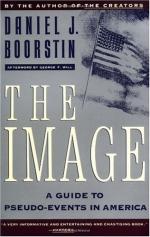
|
| Name: _________________________ | Period: ___________________ |
This test consists of 5 multiple choice questions, 5 short answer questions, and 10 short essay questions.
Multiple Choice Questions
1. When did Karl Baedeker institute a star system in his travel guides?
(a) 1867.
(b) 1859.
(c) 1902.
(d) 1844.
2. According to Walter Lippman, a ____ is a way of giving rapid meaning to an external person or situation to help one orient to a world full of confusing and overwhelming experiences.
(a) Stereotype.
(b) Propaganda.
(c) Pseudo-event.
(d) Archetype.
3. Who does Boorstin claim was a major figure of presidential creation of pseudo-events, including his solidification of the presidential press conference and his fireside chats?
(a) Franklin D. Roosevelt.
(b) John F. Kennedy.
(c) Dwight Eisenhower.
(d) Hubert Humphrey.
4. What was one of Charles Lindbergh's nicknames?
(a) Lucky Lindy.
(b) The Flyer.
(c) Lucky Chuck.
(d) Wings.
5. When did Al Capone die?
(a) 1949.
(b) 1951.
(c) 1965.
(d) 1947.
Short Answer Questions
1. What political party did Benito Mussolini lead?
2. In what year did Karl Baedeker start his publishing company?
3. How many people did Thomas Cook claim to have arranged to attend the Great Exhibition?
4. What word means to represent concretely, to externalize?
5. Who wrote Mein Kampf?
Short Essay Questions
1. What does Boorstin write all tourist attractions share, in Chapter 3 - Section IV? What effect does this have on travelers?
2. How did the "Crime of the Century" affect Lindbergh's celebrity?
3. How does Boorstin distinguish pseudo-events from propaganda?
4. What subject does Boorstin address in Chapter 1 - Section V? How have pseudo-events distorted image?
5. What is the effect of the extravagant expectations held by Americans, according to Boorstin?
6. What does Boorstin assert of travelers' dissociation since the advent of tourism?
7. How does Boorstin describe pseudo-events in the political arena, in Chapter 1 - Section III? What examples does he offer?
8. What does Boorstin write of the American concept of "greatness," in Chapter 2 - Section I?
9. How did Charles Lindbergh succumb to celebrity, according to Boorstin?
10. What does Boorstin relate of technology and the sciences in Chapter 2 - Section II?
|
This section contains 780 words (approx. 3 pages at 300 words per page) |

|




